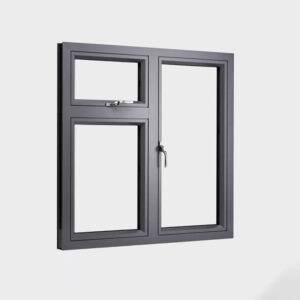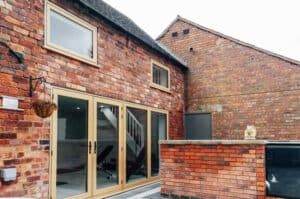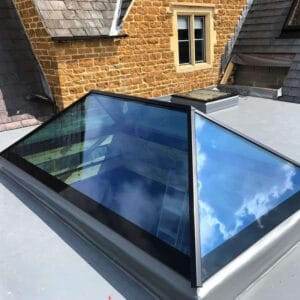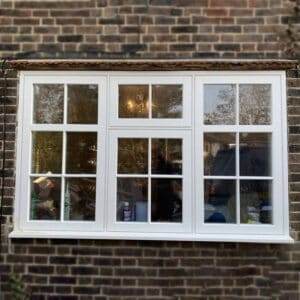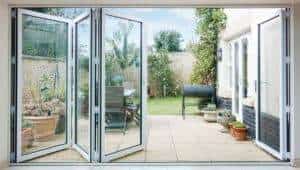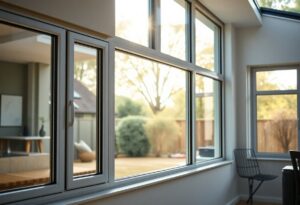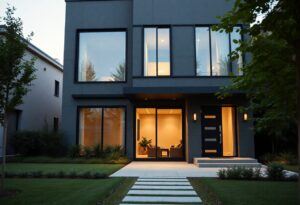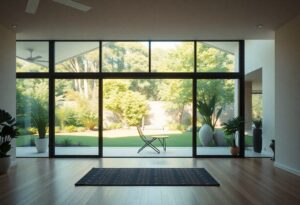Steel is not just a strong structural element; it’s also a key player in the development of energy-efficient steel windows. By understanding the interplay between rolled steel profiles and high-performance glazing, you can appreciate how these technologies enhance your home’s energy efficiency, comfort, and design. This blog post will guide you through the science behind these innovations, empowering you to make informed decisions about your building projects and the benefits they can bring.
The Evolution of Steel Window Design
The evolution of steel window design reflects shifts in architectural trends, technology, and energy efficiency. Initially, these windows were recognised for their strength and slender profiles, but as demands for better aesthetics and performance grew, designs evolved to incorporate modern materials and innovative engineering techniques.
Historical Context
The application of steel in window design can be traced back to the late 19th century, where it emerged as a practical solution for large openings and structural support. Early designs were predominantly utilitarian, aimed at offering robustness and security, while gradually transforming with the incorporation of stylistic elements that complemented various architectural movements.
Advances in Materials
After decades of innovation, advances in materials have dramatically reshaped the landscape of steel window design. The introduction of high-performance glazing and thermally broken frames has enabled steel windows to meet modern energy efficiency standards while enhancing aesthetic appeal.
Further developments in materials science have led to the creation of lightweight, durable frames that maintain the classic steel look without compromising performance. You can now enjoy benefits such as improved thermal insulation and sound reduction, making your spaces more comfortable and energy-efficient. Advanced finishes and coatings have also emerged, providing greater resistance to corrosion and ensuring long-lasting beauty in every installation.
Understanding Energy Efficiency in Building Design
Clearly, energy efficiency plays a vital role in modern building design, as it directly impacts both environmental sustainability and the long-term financial viability of a property. By integrating energy-efficient practices and materials, you can reduce energy consumption, lower utility bills, and contribute to a lower carbon footprint, ultimately creating a more comfortable living or working environment.
Importance of Energy Performance
Any building’s energy performance is fundamental in determining its overall efficiency. You should consider that not only does it influence operational costs, but it also affects occupant comfort and wellbeing. By prioritising energy performance, you can enhance property value and meet increasingly stringent regulatory standards.
Metrics for Evaluation
Across the industry, various metrics are employed to assess energy efficiency, enabling you to gauge the effectiveness of your building’s design and performance. From Energy Use Intensity (EUI) to the Building Energy Rating (BER), these metrics offer a comprehensive view of how your building consumes energy.
In addition, utilising tools like the Energy Star Portfolio Manager or LEED certification can provide you with valuable insights into your building’s energy performance. These metrics not only assist in tracking energy use over time, but also highlight areas for improvement, ensuring your building meets energy efficiency standards. By actively monitoring and evaluating these metrics, you can make informed decisions that enhance your building’s performance, promote sustainability, and comply with important regulations while optimising costs.

Rolled Steel Profiles: The Foundation of Strength
One of the key components in the construction of energy-efficient steel windows is the rolled steel profile. These profiles act as the backbone, providing exceptional strength and durability. This foundation enables windows to withstand various environmental conditions while maintaining structural integrity. As a result, you can ensure your installations not only perform well but also offer long-lasting reliability.
Manufacturing Processes
Processes involved in creating rolled steel profiles are meticulously designed to enhance material properties. Techniques such as hot rolling and cold forming allow manufacturers to achieve desired shapes, thicknesses, and mechanical strengths. By adhering to strict quality control measures, you can trust that the profiles produced meet industry standards and deliver performance expectations.
Structural Benefits
Structural integrity is one of the standout advantages of using rolled steel profiles in your window installations. This material ensures a robust framework that can support significant loads while remaining lightweight. This translates to enhanced energy efficiency, as well as reduced risk of deformation or failure over time. Furthermore, the long lifespan of steel profiles means fewer replacements and lower maintenance costs, making it a smart investment for your projects.
This strength-to-weight ratio optimises your window designs, allowing for larger glass panes with minimal framing, enhancing both aesthetics and functionality. Additionally, the resistance to corrosion ensures that your windows can endure the test of time, providing peace of mind that they will last. By selecting rolled steel profiles, you are making a committed choice towards sustainability and energy efficiency in your buildings.
High-Performance Glazing Technologies
Your choice of high-performance glazing is vital for enhancing the energy efficiency of steel windows. Advanced glazing solutions optimise thermal insulation and solar control, ensuring your living spaces remain comfortable while reducing energy consumption. These technologies involve multiple layers, coatings, and gas fills to achieve superior performance.
Types of Glazing
Your understanding of glazing types can greatly influence the energy performance of your windows. Here are some key types of glazing:
- Double Glazing
- Triple Glazing
- Low-E Glass
- Unglazed
- Acoustic Glass
Assume that selecting the right type can significantly impact insulation and energy efficiency.
| Glazing Type | Performance Feature |
| Double Glazing | Standard thermal performance |
| Triple Glazing | Enhanced insulation |
| Low-E Glass | Reduced heat loss and solar gain |
| Unglazed | No thermal performance |
| Acoustic Glass | Noise reduction capabilities |
Thermal and Optical Properties
After exploring the types of glazing, you will find that thermal and optical properties play a key role in the effectiveness of high-performance glazing. Understanding how these properties interact allows you to select the ideal glazing for your environment.
To optimise your building’s energy efficiency, ensure you consider both the thermal and optical properties of the glazing. These factors determine how well your windows will insulate your property and manage solar heat. For instance, low-emissivity (Low-E) coatings allow sunlight to enter while blocking heat from escaping, providing warmth in winter and coolness in summer. Moreover, the U-value indicates thermal performance: a lower value signifies superior insulation. Choosing the right glazing based on these properties can lead to significant reductions in energy bills while enhancing comfort in your living spaces.

Integration of Steel Profiles and Glazing
Now, the integration of steel profiles and high-performance glazing plays a pivotal role in enhancing the energy efficiency and aesthetic appeal of windows. By creating a seamless connection between strong, durable steel frames and advanced glazing systems, you ensure that your windows not only provide structural integrity but also maximise thermal insulation and solar control. This synergy is necessary for modern architectural designs that demand both functionality and beauty.
Design Considerations
To achieve optimal energy efficiency in your steel windows, you must consider factors such as the profile size, glazing type, and overall frame design. High-quality thermal breaks within the steel profiles can significantly enhance performance, while careful selection of glazing solutions ensures superior thermal and acoustic insulation. Thoughtful design will yield windows that meet both aesthetic requirements and energy performance standards.
Case Studies of Successful Implementations
Profiles of successful implementations highlight the effectiveness of energy-efficient steel windows:
- Project A: Retrofit of a historic building using thermal break profiles and triple glazing, resulting in a 40% reduction in energy costs.
- Project B: Newly constructed office in London, featuring stainless steel frames and solar control glazing, which enhanced natural light while maintaining a 7% improvement in energy ratings.
- Project C: Residential development utilising steel-framed windows with high-performance dual glazing, achieving a 60% decrease in heat loss compared to standard windows.
At this stage, you can see how the benefits of energy-efficient steel windows can be demonstrated through these remarkable case studies. Each project showcases the potential of incorporating steel profiles and advanced glazing technology to enhance both *energy performance* and *visual impact*. With numbers highlighting substantial improvements, these examples underscore the positive difference that well-integrated steel windows can make in a variety of settings.
Environmental Impact and Sustainability
Many brands are now prioritising sustainability in their manufacturing processes, especially in the production of steel windows. By utilising The Strength of Steel Windows, manufacturers can achieve durability and energy efficiency, significantly reducing environmental impact. The recycling potential of steel also plays a vital role in promoting a more sustainable approach to construction, ensuring that you make a responsible choice for your projects.
Life Cycle Assessment
Below is an important aspect to consider when evaluating the sustainability of steel windows. A comprehensive Life Cycle Assessment (LCA) analyses the environmental impact of a product from raw material extraction through to production, usage, and disposal. When you embrace steel windows, you’re investing in materials that can demonstrate a longer life span and lower carbon footprint throughout this cycle.
Future Trends in Green Construction
After assessing current methods, it’s evident that innovative strides are being made in green construction practices. One notable trend is the integration of smart technologies that optimise energy use in buildings, making your living spaces even more efficient. As you explore the market for steel windows, look for those that incorporate these advancements.
Hence, the future of green construction is leaning heavily towards an intelligent blend of natural and synthetic materials, alongside enhanced technology. You will find that innovative building materials – including high-performance glazing and energy-efficient structures – are becoming more prevalent. Emphasising renewable resources and waste reduction will inspire more sustainable designs. The shift is evident, and as you engage in the market, embracing these advancements in steel window technology will position you at the forefront of eco-friendly building practices.
Final Words
Now that you understand the journey from rolled steel profiles to high-performance glazing, you can appreciate the innovative science behind energy-efficient steel windows. By selecting these windows, you’re not only enhancing your property’s aesthetic appeal but also contributing to energy conservation and cost savings. For further insights on improving your home’s efficiency, explore more about Energy Efficient Window Coverings. Empower yourself with knowledge to make informed decisions that benefit both your home and the environment.
FAQ
Q: What are rolled steel profiles and how are they used in window construction?
A: Rolled steel profiles are sections of steel that have been shaped using a rolling process. In window construction, these profiles provide the structural framework for frames and sashes, lending strength and durability while allowing for slimmer lines compared to traditional materials. This combination not only enhances the aesthetic appeal but also improves the overall energy efficiency of the windows.
Q: How do high-performance glazing systems contribute to energy efficiency?
A: High-performance glazing systems utilise advanced technologies like low-emissivity coatings and multiple glazing layers to reduce heat transfer. This means they can keep indoor spaces warmer in winter and cooler in summer, thus decreasing the reliance on heating and cooling systems. Such systems are imperative in achieving a higher energy rating for windows, contributing to lower energy consumption overall.
Q: What factors should be considered when selecting steel windows for energy efficiency?
A: When dicking out steel windows, it is important to assess the thermal performance of the materials, including the U-value, which measures heat transfer. Additionally, the type of glazing used, the integrity of the seals, and the overall design of the window should be analysed. Effective installation is also vital to prevent air leaks, which can undermine energy efficiency regardless of the materials used.
Q: Are there specific maintenance requirements for energy-efficient steel windows?
A: Energy-efficient steel windows do require maintenance to ensure their performance is sustained over time. Regular inspection of seals, checking for corrosion, and ensuring that the glazing remains intact are important to maintain the window’s efficiency. Cleaning the glass and frames periodically will also help preserve their appearance and functionality, ensuring long-term energy savings.
Q: How does the use of energy-efficient steel windows impact overall building sustainability?
A: The integration of energy-efficient steel windows significantly enhances a building’s sustainability profile. By reducing energy consumption through effective insulation and innovative glazing, these windows lower greenhouse gas emissions associated with heating and cooling. Furthermore, their durability means they often require less frequent replacement, contributing to reduced material waste over the lifecycle of the building.

